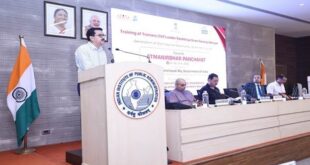Recently, the Union Minister of Panchayati Raj released a Model Panchayat Citizens Charter.
Important points:
- It is prepared by the Ministry of Panchayati Raj (MoPR) in collaboration with National Institute of Rural Development & Panchayati Raj (NIRDPR).
- NIRDPR is an autonomous organisation under the Union Ministry of Rural Development.
- It has been developed for the delivery of the services across the 29 sectors, aligning actions with localised Sustainable Development Goals (SDGs).
- It is expected that the Panchayats utilising this framework, and with the due approval of Gram Sabha, would draw up a Citizens Charter, detailing the different categories of services rendered to the citizen by the Panchayat, the conditions for such service and also the time limit for such service.
- It will help in making the citizens aware of their rights on the one hand, and to make the Panchayats and their elected representatives directly accountable to the people, on the other hand.
Significance:
- Panchayati Raj Institutions (PRIs) constitute the third tier of government in the rural areas and represent the first level of Government interaction for over 60% of the Indian population.
- PRIs are responsible for delivery of basic services as enshrined under Article 243G of the Constitution of India, specifically in the areas of Health & Sanitation, Education, Nutrition, Drinking Water.
Citizen’s Charter
- It is a voluntary and written document that spells out the service provider’s efforts taken to focus on their commitment towards fulfilling the needs of the citizens/customers.
- It preserves the trust between the service provider and the citizens/users.
- It includes what the citizens can expect out of the service provider.
- It also includes how citizens can redress any grievances.
- The concept was first articulated and implemented in the United Kingdom by the Conservative Government of John Major in 1991 as a national Programme.
- Citizen’s charters are not legally enforceable documents. They are just guidelines to enhance service delivery to citizens.
Indian Initiative:
- In India, the concept of citizen’s charter was first adopted at a ‘Conference of Chief Ministers of various States and Union Territories’ held in May 1997.
- A major outcome of the conference was a decision to formulate Citizen’s Charters by the central and state governments, beginning with sectors with a large public interface such as the railways, telecom, posts, Public Distribution System, etc
- The task of coordination, formulation, and operationalization of citizen’s charters was done by the Department of Administrative Reforms and Public Grievances (DARPG).
- The Right of Citizens for Time Bound Delivery of Goods and Services and Redressal of their Grievances Bill, 2011 (Citizens Charter) was introduced in the Lok Sabha in December 2011.
- It lapsed due to the dissolution of the Lok Sabha in 2014.
Need:
- To make administration accountable and citizen friendly.
- To ensure transparency.
- To take measures to improve customer service.
- To adopt a stakeholder approach.
- To save time for both Administration and the citizens.
Challenges in India:
- In a majority of cases, not formulated through a consultative process with cutting edge staff who will finally implement it.
- Lack of meaningful and succinct Citizen’s Charter, absence of critical information that end-users need to hold agencies accountable.
- Only a small percentage of end-users are aware of the commitments made in the Citizen’s Charter.
- Measurable standards of delivery are rarely defined making it difficult to assess whether the desired level of service has been achieved or not.
- Little interest shown by the organizations in adhering to their Citizen’s Charter since there is no citizen friendly mechanism to compensate the citizen if the organization defaults.
- Citizen’s Charter has still not been adopted by all Ministries/Departments. This overlooks local issues.
Way Forward
- A Citizens’ Charter cannot be an end in itself, it is rather a means to an end – a tool to ensure that the citizen is always at the heart of any service delivery mechanism.
- Drawing from best practice models such as the Sevottam Model (a Service Delivery Excellence Model) can help Citizen’s Charter in becoming more citizen centric.
SOURCE: THE HINDU,THE ECONOMIC TIMES ,MINT
 Chinmaya IAS Academy – Current Affairs Chinmaya IAS Academy – Current Affairs
Chinmaya IAS Academy – Current Affairs Chinmaya IAS Academy – Current Affairs



